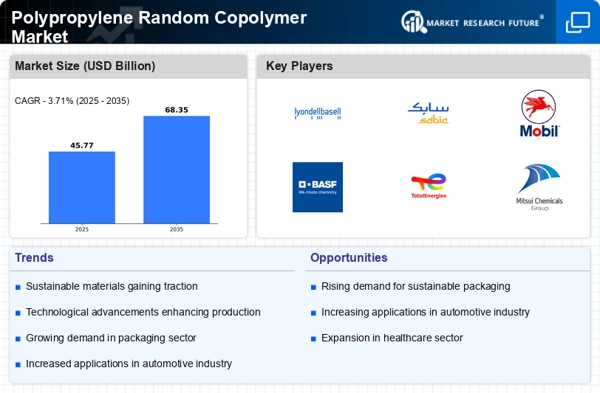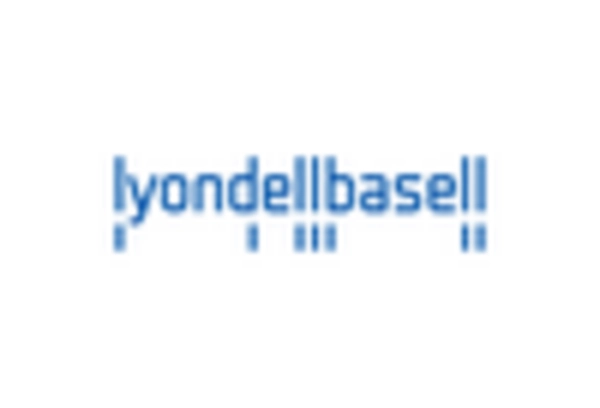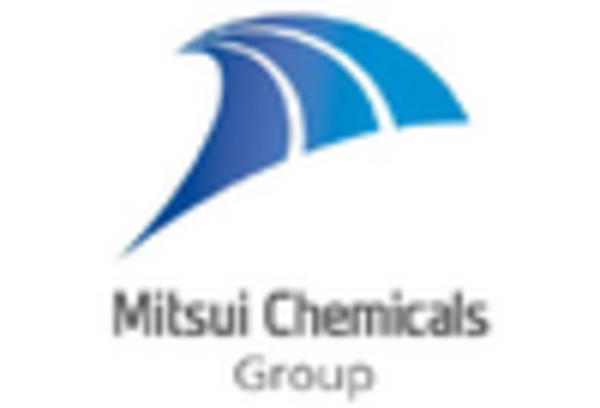The Polypropylene Random Copolymer Market is currently characterized by a dynamic competitive landscape, driven by increasing demand across various sectors such as automotive, packaging, and consumer goods. Key players are actively engaging in strategies that emphasize innovation, sustainability, and regional expansion to enhance their market positions. For instance, LyondellBasell Industries (US) has been focusing on expanding its production capabilities to meet the rising demand for high-performance materials, while SABIC (SA) is leveraging its technological expertise to develop advanced polymer solutions that cater to evolving customer needs. These strategic initiatives collectively contribute to a competitive environment that is increasingly shaped by the need for differentiation through product quality and sustainability.
In terms of business tactics, companies are increasingly localizing manufacturing to reduce lead times and optimize supply chains. This approach appears to be particularly effective in a moderately fragmented market where several players vie for market share. The collective influence of key players, such as ExxonMobil Chemical (US) and BASF (DE), suggests a trend towards consolidation, as these companies seek to enhance their operational efficiencies and market reach through strategic partnerships and acquisitions.
In August 2025, ExxonMobil Chemical (US) announced the launch of a new line of polypropylene random copolymers designed specifically for the automotive sector, which is expected to enhance fuel efficiency and reduce emissions. This strategic move underscores the company's commitment to innovation and sustainability, positioning it favorably in a market that increasingly prioritizes environmentally friendly solutions. The introduction of these advanced materials could potentially reshape product offerings in the automotive industry, driving further adoption of polypropylene solutions.
In September 2025, BASF (DE) unveiled a partnership with a leading technology firm to integrate AI-driven analytics into its production processes. This initiative aims to optimize manufacturing efficiency and reduce waste, aligning with the growing trend of digital transformation within the industry. By harnessing AI capabilities, BASF is likely to enhance its competitive edge, enabling it to respond more swiftly to market demands and improve overall product quality.
Moreover, in July 2025, TotalEnergies (FR) announced a significant investment in a new facility dedicated to producing sustainable polypropylene random copolymers. This facility is expected to utilize renewable feedstocks, reflecting the company's strategic pivot towards sustainability. Such investments not only bolster TotalEnergies' market position but also signal a broader industry shift towards eco-friendly production practices, which are becoming increasingly critical in attracting environmentally conscious consumers.
As of October 2025, the competitive trends within the Polypropylene Random Copolymer Market are heavily influenced by digitalization, sustainability, and the integration of advanced technologies. Strategic alliances are playing a pivotal role in shaping the current landscape, as companies collaborate to enhance their capabilities and market offerings. Looking ahead, it appears that competitive differentiation will increasingly hinge on innovation, technological advancements, and the reliability of supply chains, moving away from traditional price-based competition. This evolution suggests a market poised for transformation, where companies that prioritize sustainable practices and technological integration are likely to emerge as leaders.

















Leave a Comment